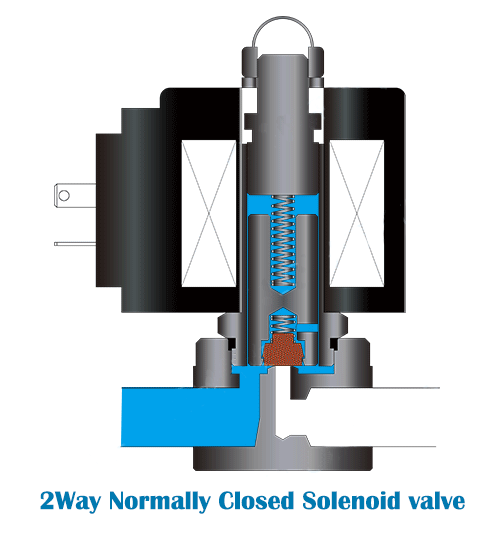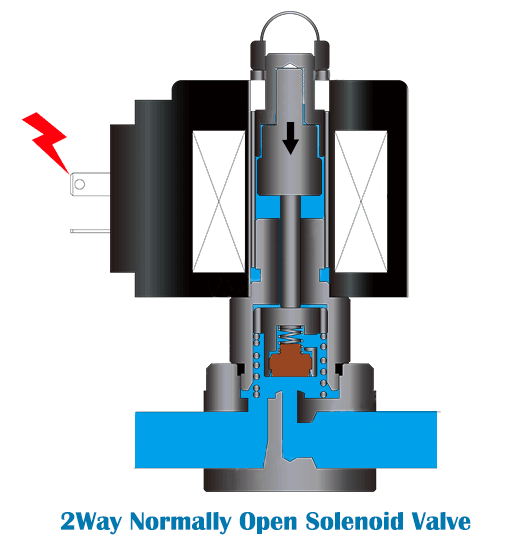An electronic solenoid valve functions as a control mechanism for regulating the flow of liquids or gases, akin to its valve counterparts. Its primary components consist of a valve body with attached wires, with the upper section housing the solenoid and the lower part comprising the valve itself. Notably, the valve can be oriented at various angles to accommodate specific requirements.
Manufacturers may introduce some design variations, and there are distinctions between 2-way and 3-way solenoid valves, the latter featuring an additional exhaust port.
The most basic iteration of a solenoid valve is the directly operated valve. In this design, the upper section typically consists of a coil of wire forming the solenoid. When an electrical current flows through this coil, it generates an electromagnetic field, which in turn governs the movement of the valve.
Since these valves incorporate a solenoid, their operation, whether opening or closing, hinges on the electric current and the valve type (normally open or normally closed). Later in this article, we will delve into the nuances of how normally open and normally closed valves function.
Here are GIF images to show how it works:


Benefits of a Solenoid Valve
Solenoid valves offer a multitude of advantages, making them a valuable choice across diverse applications. These benefits encompass:
- Energy Efficiency: Solenoid valves are known for their low power consumption, contributing to cost savings in energy-intensive operations.
- Remote Control and Automation: These valves are easily integrated into automated systems, enabling remote control and enhancing operational efficiency.
- Cost-Effective Maintenance: Solenoid valves come equipped with easily replaceable parts, reducing downtime and maintenance expenses.
- Temperature Versatility: They excel in both high and low-temperature environments, ensuring reliable performance under extreme conditions.
- Installation Flexibility: Solenoid valves can be positioned horizontally or vertically, adapting seamlessly to various system configurations.
- Compatibility: They harmonize with an array of machinery components and applications, making them a versatile choice across industries.
Solenoid Valve Example: Automated Sprinklers
One of the most popular home automation concepts involves the creation of an automated in-ground sprinkler system. This can be achieved through the use of either a basic timer system or by integrating a smart home system for control. However, let’s delve into the underlying mechanics of what these timer or smart home programs are actually managing.
In most cases, these systems oversee the operation of multiple solenoid valves situated within the sprinkler system. When these valves are in the “off” position, they act as barriers, preventing water from flowing through the sprinkler network. When activated, these valves open up, allowing water to course through and nourish your lawn, garden, or outdoor plants. Additionally, different solenoid valves strategically placed within the irrigation setup can be individually controlled to supply water to distinct zones, offering precise irrigation management.
HOW DO 2-WAY VALVES WORK?
A two-way normally closed solenoid valve comprises two interconnected pipe connections: an inlet, known as the cavity port, and an outlet, referred to as the body orifice port.
The valve’s operation is governed by an electrical current that flows through the solenoid. When the valve receives power, the plunger inside it shifts to an open position, allowing the passage of liquid or gas through the valve, from the cavity port to the body orifice port.
Conversely, when the power supply is deactivated, the orifice is sealed shut, halting the flow of substances through the valve. Essentially, when the power is switched off, the plunger descends and firmly seals the orifice, closing the valve. Pressurized gas or liquid is then directed into the valve’s cavity through the cavity port.
As an electric current courses through the coil, it generates a magnetic field. This magnetic field prompts the plunger to ascend within the valve, thereby unlocking the orifice and permitting the valve to open. Subsequently, the pressurized gas or liquid can traverse through the valve.
NORMALLY OPEN SOLENOID VALVES
In the case of a normally open solenoid valve, the coil is also positioned around the armature section. However, a spring exerts an upward force on the plunger, resulting in the valve remaining in the open position by default until an electric current flows through the solenoid coil.
When an electric current is applied to the solenoid coil, it generates an electromagnetic field, similar to what occurs in a normally closed solenoid valve. However, the key distinction here is that in a normally open solenoid valve, this electromagnetic field pushes the plunger downward, as opposed to the upward movement seen in normally closed solenoid valves.
As the plunger is pushed downward in this scenario, it effectively closes the valve, preventing the flow of fluids or gases into the system. In the absence of an electric current, the fluid or gas continues to flow continuously through the system.
When the electric current is deactivated, the spring’s force propels the plunger upward once more, reopening the valve.
It’s worth noting that the fundamental working principles of a normally closed solenoid valve are quite similar, utilizing the same underlying principles of solenoid valve operation. However, the key distinction lies in the reversal of the valve’s default state and operation, as elaborated in the following section.
NORMALLY CLOSED SOLENOID VALVES
In the case of a normally closed solenoid valve, its default state is in the “off” position, effectively blocking the flow of any media.
When the solenoid valve is in its resting state, no electrical current flows through the wires, and the movable core component, known as the armature, is positioned at the base of the valve, obstructing the passage of liquid or gas.
The solenoid is strategically placed around the armature, precisely at the center of the electromagnetic field. Within the armature, you’ll find the plunger and a spring. In the “off” position, the spring exerts force, holding the plunger in a downward position, which, in turn, keeps the valve firmly closed.
However, when an electrical current is applied to the coil of wire, it generates an electromagnetic field. This magnetic field acts upon the plunger, compelling the core to move upward against the spring’s resistance, thereby opening the valve. This pivotal moment allows the rapid flow of gas or liquid through the now-open valve. Notably, the plunger is strategically positioned at the center of the coil because this is where the electromagnetic field lines are most concentrated and potent.
Upon deactivation of the electrical current, the magnetic field dissipates, causing the core to return to its original lower position. The spring then exerts its downward force on the plunger, sealing the valve shut.
In essence, this is how a normally closed solenoid valve operates: it remains closed until an electrical current is introduced to initiate the valve’s opening.
Still Have Questions?
Our team of solenoid valve specialists is here to assist you with any inquiries you may have within our standard business hours. You can reach out to us via email, telephone to receive expert guidance in identifying your specific valve requirements.
